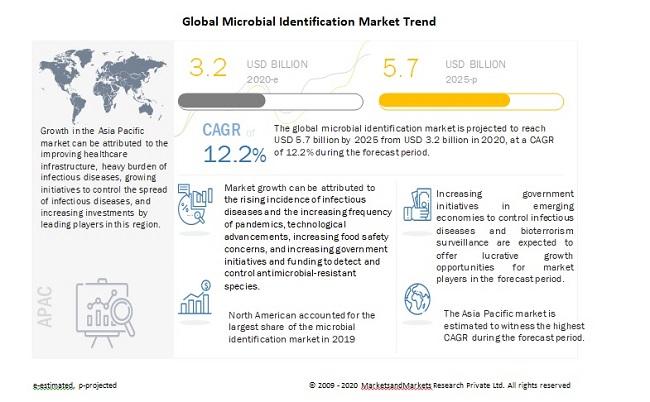The rising incidence of infectious diseases and the increasing frequency of pandemics, technological advancements, increasing food safety concerns, and increasing government initiatives and funding to detect and control antimicrobial-resistant species.
According to market research report, "Microbial Identification Market by Product & Service (Instrument & Software, Consumable, Service), Method (Phenotypic, Proteomic), Technology (Mass Spectrometry, PCR), Application (Diagnostic, Food Testing), End User (Hospital) – Global Forecast to 2025", The global microbial identification market size is estimated to be USD 3.2 billion in 2020 and projected to reach USD 5.7 billion by 2025, at a CAGR of 12.2%.
The COVID-19 pandemic has had a major impact on the US, China, India, as well as many major European countries. Since most of these countries are major manufacturers of the instruments and consumables used for microbial identification, the pandemic and nationwide lockdowns have caused a decline in the sales of these products.

Download PDF Brochure @ https://www.marketsandmarkets.com/pdfdownloadNew.asp?id=10702182
Microbial identification is mainly used for human disease diagnosis. It delivers rapid and reliable results that help in the timely adoption of appropriate therapies. Microbial identification products can improve the management of infectious diseases, especially in areas with inadequate healthcare infrastructure.
Automated microbial identification systems are priced within the range of USD 50,000 to USD 75,000. Pharmaceutical companies require many such systems and, hence, the capital cost increases significantly. Academic research laboratories generally cannot afford such systems as they have limited budgets.
The consumables used for identification techniques are also expensive, and there is an added labor cost. Many of the new rapid tests typically range from USD 100–USD 250; they cost significantly more than the conventional culture methods. The estimated cost for instruments, media, and labor is excessively high for some end users.
Some of the leading players in the microbial identification market include bioMérieux SA (France), Becton, Dickinson and Company (US), Thermo Fisher Scientific Inc. (US), Danaher Corporation (US), Merck KGaA (Germany), Bruker Corporation (US), Shimadzu Corporation (Japan), QIAGEN NV (Netherlands), Avantor, Inc. (US), and Biolog, Inc. (US).
